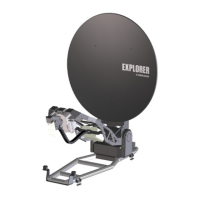Prerequisites for installation
98-145510-E Chapter 5: Initial setup and basic functions 5-2
If you cannot avoid obstacles, you must define a blocking zone to make sure the equipment
is not damaged. See Blocking zones on page 6-11.
Unexpected antenna movements
The movements of the antenna can be very powerful and hazardous to human beings. For
this reason, the antenna has a safety feature that prevents or limits unexpected movements
of the antenna, e.g. if the antenna has to repoint after a period with no movements. In this
case, you can set up the antenna so that the user must actively choose to continue. If you
need to avoid user interaction to allow the antenna to continue operation, you can set up
the antenna for Unmanned operation. See Antenna stabilization and safety on page 6-10.
Avoid magnetizable material
Make sure the vehicle with the antenna is not parked close to large areas of magnetizable
material, as this could interfere with the precision of the compass function.
5.2.2 Wind speed considerations
The antenna is designed to operate under high wind speeds, see the wind speed
specifications on page A-3. Note that the antenna may point away from the satellite in
winds blowing faster than the operational wind speed limit.
WARNING! Make sure nobody can get close to the antenna, especially if
you use the unmanned operation feature! Observe the stay clear area
whenever the antenna is powered. See the mechanical stay-clear areas on
page vi and page vii.
Do not operate the terminal at wind speeds exceeding the operational wind
speeds. In case the wind speeds exceed the operational wind speed limit
while the antenna is already assembled or operational, bring the antenna to
the stow position. In case the wind speeds exceed the survival wind speed
limit while the antenna is already assembled or operational, and you cannot
stow the antenna with the electronic stow function, bring the antenna
manually back to the stow position. See To stow and unfold the antenna
manually on page 7-9.

